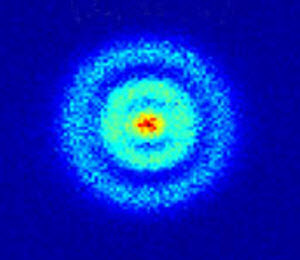Atom Orbitals
An atom is a system of one or more electrons bound to a nucleus. Here is a quantum microscope image of a hydrogen atom:

https://dx.doi.org/10.1103/PhysRevLett.110.213001
Hydrogen has just one electron that exists as a fuzzy probability cloud.
That probability cloud is called an orbital (not orbit):
Orbital: a region where there is a 90% chance of finding an electron.
The simplest orbital is the "s" orbital (such as the single electron in Hydrogen):
s orbital
But we can have more than one orbital, each with a different energy state.
First, play with the different vibration modes we get on a simple string:
Now play with the interesting vibration modes on a 2D surface like a drum:
(Note for the curious: the above animation uses the "Bessel Function" to calculate the different ways a surface can vibrate when it is fixed at its edges.)
Now imagine the vibration modes around a nucleus!
Well, here they are, with labels:
orbitals s, p, d and f
Each orbital shape represents a different way electrons can exist around the nucleus.
- An orbital can have up to two electrons (each with opposite "spin")
- Electrons prefer to be at the lowest energy state possible
- The s orbital has the lowest energy state then p, d and f
But there is one more twist! An atom hosts electrons in shells:
Carbon atom with two shells
- the 1st shell (n=1) only has an s orbital
- the 2nd shell (n=2) can have s and p orbitals
- the 3rd shell (n=3) can have s, p and d orbitals
- the 4th shell (n=4) can have s, p, d and f orbitals
- later shells can also have s, p, d and f orbitals (no more are needed for the elements we know!)
So, with different orbitals available at different shells ...
... where does each electron go?
Well, it is like packing things into a box, the items find their lowest energy locations.
For each electron we have the energy needed for the shell plus the energy needed for the orbital.
And we get this (notice how energy levels overlap):
energy of shell plus orbital
The order goes 1s, 2s, 2p, 3s, 3p, 4s, 3d, 4p, 5s, 4d, etc. But there are exceptions! Those pesky electrons don't like to be told what to do except by nature.
But other things can happen to an atom.
For example radiation can knock an electron out of the atom, read about radiation to learn more.
And an electron can 'jump' between orbitals, emitting or absorbing light of specific frequencies.

Glow sticks shine because a reaction energizes electrons, making them jump to higher orbitals, then fall back emitting light.
Summary
- Electrons prefer to be at the lowest energy state possible
- Each electron has an orbital, a region of space the electron is likely to be in
- Each orbital from s to p, d and f has a higher energy state
- Orbitals are in shells around the atom:
- the 1st shell (n=1) only has an s orbital
- the 2nd shell (n=2) can have s and p orbitals
- the 3rd shell (n=3) can have s, p and d orbitals
- the 4th shell (n=4) can have s, p, d and f orbitals
- Each orbital can have up to two electrons (each with opposite "spin")
- Together these define where the electrons will be
The arrangement of electrons, particularly the outermost electrons, causes chemical behavior.
Now it is time to learn about the Periodic Table and Electrons to see more of the story!